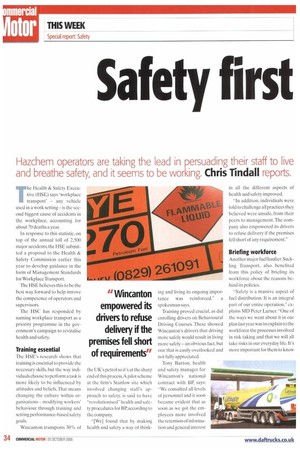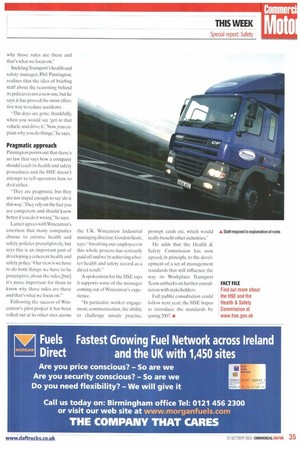Safety first
Page 34

Page 35

If you've noticed an error in this article please click here to report it so we can fix it.
Hazchem operators are taking the lead in persuading their staff to live and breathe safety, and it seems to be working. Chris Tindall reports.
The Health & Safety Executive (HSE) says 'workplace transport' any vehicle used in a work setting-is the second biggest cause of accidents in the workplace, accounting for about 70 deaths a year.
In response to this statistic, on top of the annual toll of 2,500 major accidents, the HSE submitted a proposal to the Health & Safety Commission earlier this year to develop guidance in the form of Management Standards for Workplace Transport.
The HSE believes this to be the best way forward to help imrove the competence of operators and supervisors.
• The HSC has responded by naming workplace transport as a priority programme in the government's campaign to revitalise health and safety.
Training essential
The HSE's research shows that training is essential to provide the necessary skills, but the way individuals choose to perform a task is more likely to he influenced by attitudes and beliefs. That means changing the culture within organisations modifying workers' behaviour through training and setting performance-based safety goals.
Wincanton transports 30% of the UK's petrol so it's at the sharp end of this process.A pilot scheme at the firm's Stanlow site which involved changing staff's approach to safety, is said to have -revolutionised" health and safety procedures for BP, according to the company.
"[We] found that by making health and safety a way of think ing and living its ongoing importance was reinforced," a spokesman says.
Training proved crucial, as did enrolling drivers on Behavioural Driving Courses. These showed Wincanton's drivers that driving more safely would result in living more safely an obvious fact, but one that is easily overlooked and not fully appreciated.
Tony Burton, health and safety manager for Wincanton's national contract with BR says: "We consulted all levels of personnel and it soon became evident that as soon as we got the employees more involved the retention of information and general interest in all the different aspects of health and safety improved.
"In addition, individuals were told to challenge all practices they believed were unsafe, from their peers to management. The company also empowered its drivers to refuse delivery if the premises fell short of any requirement."
Briefing workforce
Another major fuel ha ulier, Suckling Transport, also benefited from this policy of briefing its workforce about the reasons behind its policies "Safety is a massive aspect of fuel distribution. It is an integral part of our entire operation," explains MD Peter Lamer. "One of the ways we went about it in our plan last year was to explain to the workforce the processes involved in risk taking and that we will all take risks in our everyday life. It's more important for them to know why those rules are there and that's what we focus on."
SucklingTransport's health and safety manager, Phil Pinnington, realises that the idea of briefing staff about the reasoning behind its policies is not a new one, but he says it has proved the most effective way to reduce accidents.
"The days are gone, thankfully, when you would say 'get in that vehicle and drive it.' Now, you explain why you do thing,,.he says.
Pragmatic approach Pinnington points out that there's no law that says how a company should teach its health and safety procedures, and the HSE doesn't attempt to tell operators how to do it either.
"They are pragmatic, but they are not stupid enough to say 'do it this way'.They rely on the fact you are competent and should know better if you do it wrong," he says.
Lamer agrees with Wincanton's assertion that many companies choose to enforce health and safety policies prescriptively, but says this is an important part of developing a coherent health and safety policy."Our view is we have to do both things: we have to be prescriptive about the rules, [but] its more important for them to know why those rules are there and that's what we focus on."
Following the success of Wincanton's pilot project it has been rolled out at its other sites across the UK. Wincanton Industrial managing director. Gordon Scott, says:"Involving our employees in this whole process has seriously paid off and we're achieving a better health and safety record as a direct result."
A spokesman for the USE says it supports some of the messages coming out of Wincanton's experience.
"In particular, worker engagement, communication, the ability to challenge unsafe practise, prompt cards etc, which would really benefit other industries."
He adds that the Health & Safety Commission has now agreed, in principle, to the development of a set of management standards that will influence the way its Workplace Transport Team embarks on further consultation with stakeholders.
Full public consultation could follow next year; the HSE hopes to introduce the standards by spring 2(X)7. •










































































































































































































